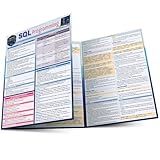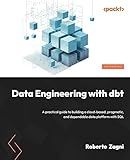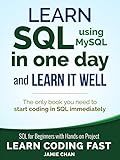Best Tools for Dynamic SQL in Oracle to Buy in January 2026

SQL Programming QuickStudy Laminated Reference Guide



Data Engineering with dbt: A practical guide to building a cloud-based, pragmatic, and dependable data platform with SQL



Practical SQL, 2nd Edition: A Beginner's Guide to Storytelling with Data



SQL Pocket Guide: A Guide to SQL Usage



SQL QuickStart Guide: The Simplified Beginner's Guide to Managing, Analyzing, and Manipulating Data With SQL (Coding & Programming - QuickStart Guides)



SQL: Learn SQL (using MySQL) in One Day and Learn It Well. SQL for Beginners with Hands-on Project. (Learn Coding Fast with Hands-On Project Book 5)


In Oracle, you can execute dynamic SQL into a cursor by using the OPEN-FOR statement. This allows you to dynamically generate and execute a SQL statement and fetch the results into a cursor variable.
To do this, you first declare a cursor variable using the CURSOR or REF CURSOR type. Then, you use the OPEN-FOR statement to dynamically assign a SQL string to the cursor variable and execute the query. Finally, you use the FETCH statement to retrieve the results from the cursor.
It is important to handle exceptions that may arise during the execution of the dynamic SQL statement to ensure the robustness and reliability of your code. Additionally, be cautious of SQL injection vulnerabilities when constructing dynamic SQL statements, and consider using bind variables to prevent these security risks.
Overall, executing dynamic SQL into a cursor in Oracle allows for flexibility and customization in querying and processing data from the database.
How to pass parameters to a dynamic SQL query in Oracle?
In Oracle, you can pass parameters to a dynamic SQL query using bind variables. Bind variables allow you to substitute values in your SQL query at runtime, which can help prevent SQL injection and improve query performance.
Here's an example of how to pass parameters to a dynamic SQL query in Oracle using bind variables:
- Construct your dynamic SQL query as a string, and include placeholders for your bind variables. For example:
DECLARE v_id NUMBER := 123; v_name VARCHAR2(50) := 'John Doe'; v_sql VARCHAR2(200); BEGIN v_sql := 'SELECT * FROM employees WHERE employee_id = :id AND employee_name = :name'; END;
- Use the EXECUTE IMMEDIATE statement to execute the dynamic SQL query, passing the bind variables as a parameter. For example:
EXECUTE IMMEDIATE v_sql USING v_id, v_name;
In the above example, the values of v_id and v_name are passed as bind variables to the dynamic SQL query. The colon (:) before the variable name in the SQL query indicates that it is a bind variable.
By using bind variables in dynamic SQL queries, you can ensure that your code is secure, efficient, and easier to maintain. Remember to validate and sanitize user input before passing it as a bind variable to prevent SQL injection attacks.
What is the syntax for declaring a cursor in Oracle?
The syntax for declaring a cursor in Oracle is as follows:
CURSOR cursor_name IS SELECT column1, column2, ... FROM table_name WHERE conditions;
Example:
CURSOR emp_cursor IS SELECT employee_id, first_name, last_name FROM employees WHERE department_id = 100;
What is the role of the cursor FOR loop in executing dynamic SQL in Oracle?
In Oracle, the cursor FOR loop is used to execute dynamic SQL statements. This type of loop is specifically designed for handling cursors that are dynamically generated at runtime.
Within the cursor FOR loop, a SQL statement is created dynamically using variables or user input. This dynamic SQL statement is then opened and executed using the cursor FOR loop. The loop iterates through the result set obtained from the dynamic SQL statement, allowing the code to process each row of the result set as necessary.
Overall, the cursor FOR loop allows for the execution of dynamic SQL in Oracle by providing a structured way to handle the result set obtained from the dynamically generated SQL statement.
What is the syntax for fetching data from a cursor in Oracle?
To fetch data from a cursor in Oracle, you can use the FETCH statement. Here is the syntax for fetching data from a cursor in Oracle:
FETCH {cursor_name | cursor_variable} INTO {variable1, variable2, ... | record};
- cursor_name: The name of the cursor from which you want to fetch data.
- cursor_variable: The name of the cursor variable from which you want to fetch data.
- variable1, variable2, ...: Variables to fetch the data into. These variables should match the data types of the columns being fetched.
- record: A record to fetch the data into. The record should have the same structure as the result set being fetched.
After fetching the data, you can process it using the fetched variables or record. Make sure to check for the %NOTFOUND attribute of the cursor after fetching data to determine if there is any more data to fetch.
How to define a cursor variable in Oracle?
To define a cursor variable in Oracle, you can use the following syntax:
DECLARE cursor_variable_name SYS_REFCURSOR; BEGIN OPEN cursor_variable_name FOR SELECT * FROM your_table_name; END;
In this example, "cursor_variable_name" is the name of the cursor variable that you are defining. You can then use this cursor variable to fetch data from a SQL query or pass it as a parameter to a stored procedure.
